Initial Proposed Final Project
MIT is not a great place to have time-consuming hobbies atUpdated Idea 2 - 12/3
After checking the *scope* of the stuff I thought I'd want to make before, I'm heading back towards one of my earliest and simplest ideas - that of a headset for people with hearing loss in one ear, which helps redirect sound from one side of their head to the other. The headset itself would be small, but there's a lot of prototyping needed to make such a thing both wearable and comfortable (and safe, and not easily broken, and not inclined towards deafening any testers further).
The parts necessary for this include:
- A lightweight (flexible, if possible) casing
- Small microphone which should fit inside the casing, on the side of the user's head that suffers from hearing loss
- Small speaker on the other side of the user's head
- Controlling board(s), shaped appropriately or located in a non-intrusive area of the headset (how?)
- (Possible: a second microphone attached to the speaker side, to detect when the user is receiving loud enough inputs from that side of their head, and turn off the speaker)
- Battery (button if possible?) to power both speaker and mic.
Design ideas
The initial design looked something like a pair of behind-the-head earphones you'd see people wearing, but then I remembered the size of things we're working with in this course.
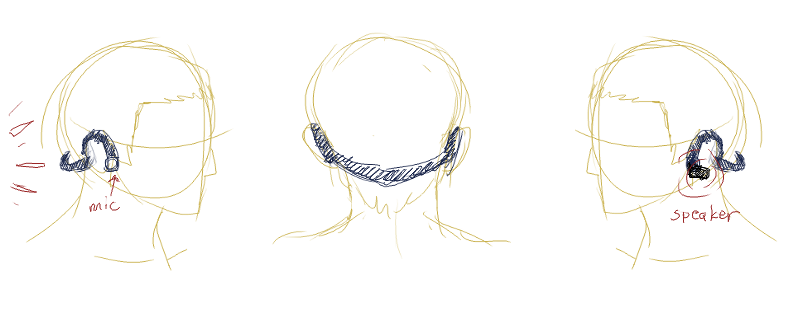
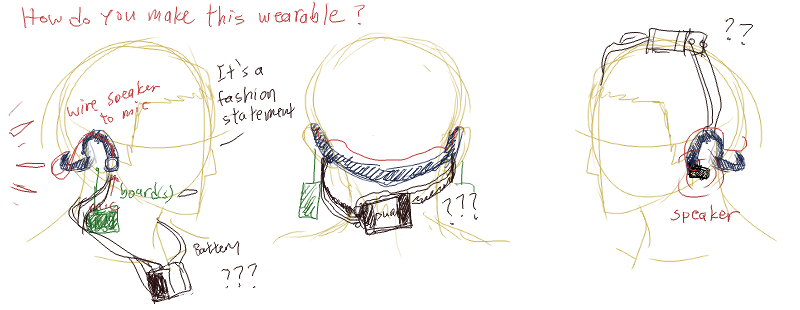
At the moment, I'm still trying to figure out what the best way to make a system like this reasonably wearable and safe would be, and that would involve enough fabrication to count for the final project.
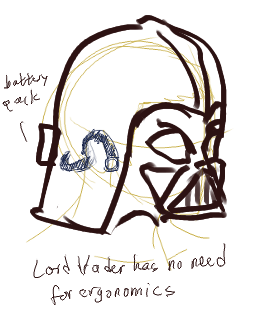
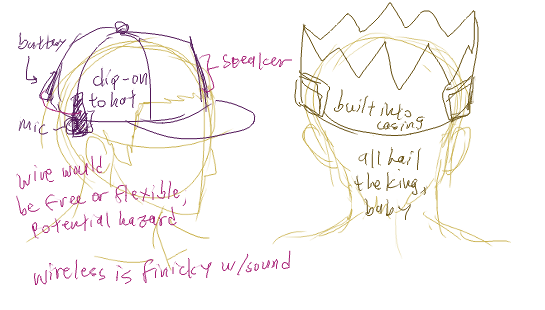
Possible issues
The other thing I'm iffy on is that to date I have not managed to build either a functioning speaker or microphone board, let alone connect them to each other to produce sound output at *reasonable* volumes. Effectively the only board I've been able to get to consistently work has been something involving LEDs; as such, it might be over-ambitious to try for a final project that depends on a speaker+microphone board combo.
Updated Idea 1
I want to make an electric guzheng. Or just a very metal one. (actually it's probably going to end up being an electric xylophone, because damn, guzheng are complex).
Making big things - use the shopbot to cut the body out of wood, laser-etch some designs into the surface, figure out how screws work and find someone who sells guzheng strings (metal? guts?), and attach a microphone + chips + LEDs to the guzheng so that certain sounds get you certain patterns of lights. Or do something else with sound amplification.
Older Ideas
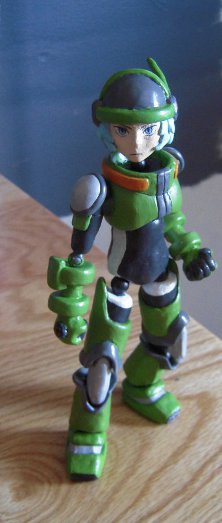
Action figures always interested me as a kid (and then later, as a grown-ass adult). They were a way for people to have a piece of their favorite character or show with them at all times, even without a TV (or internet) connected, and for the younger me at least, they provided many more opportunities for imaginative play and conversation than I might have had otherwise. Learning how to make action figures from polymer clay was one of my proudest achievements in high school, but then MIT hit and I couldn't dedicate hours of each day to working on figurines - and they are unfortunately time consuming to make.
The time commitment involved in making figures is probably why the majority of figures today are mass-produced and made only for characters of well-known television, movie, or game series, but I wonder if there's a way to make the construction process easier and more approachable for people who want to get into figuremaking as a hobby.
When internet-based communication and later social networking sprung up, people suddenly had a lot more ways to represent themselves in a digital form, which didn't have to be at all related to their physical appearance. Digital avatars are ubiquitous today, and many sites offer users the ability to customize a generic face/person to resemble themselves (or any other character they feel like making). Is it possible to extend that freedom of customization to physical figurines as well?
I want to look into the feasibility of making a figurine building kit; that is, a set of pieces that can be put together to construct a figurine, not necessarily humanoid, and customized to the user's preferences through various attachments (hair, clothing, parts). Alternatively, the shape of the figurine itself might be fixed and generic, but sensors and recording equipment can be attached to it to have it record, and play back, the user's voice or other sounds on command.